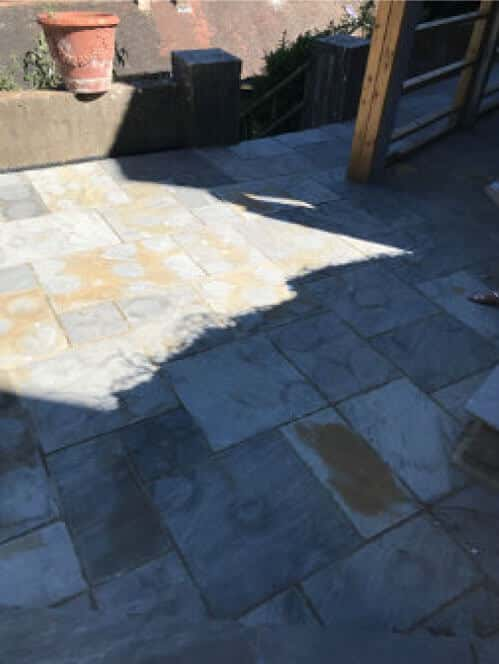Basket Preview
Natural Stone and Porcelain Paving

It is important to understand that almost all problems encountered with Natural Stone and Porcelain paving products are due to incorrect installation. Natural Stone and Timber Ltd go to every effort to ensure that our customers receive the best possible product in the best possible condition. Over the years we have seen many excellent installations ruined at the last minute by a lack of understanding of the products being used. Here is some guidance on the most common problems to hopefully prevent you from making the same mistakes. Some of these topics are covered in more detail in our natural stone and porcelain paving installation guide.

External problems are generally caused by Brick Acid Cleaner (hydrochloric Acid).
In the past your contractor would lay concrete paving slabs and clean up all the mortar spill and staining at the end of the job with an Acid wash.
This is not the case with natural stone products and this process will damage the surface of the stone and will cause irreversible damage to your patio. Here you can find information on how to clean a patio without chemicals.
Please see photo below showing the brown marks left after an acid based clear has been used.
Always ensure that you are laying all natural stone products with the finished surface visible. On most products there is a finished or selected surface, these surfaces are ready to be pointed and sealed and will give you the desired finish for your project.
If a product is described as having a flamed or brushed finish, this textured surface is the finish face of the slabs and not the smooth unfinished back, ensure that your contractor understands this before starting installation.
With products that have a hand dressed edge (such as most Indian sandstones) it is important to lay them with the chaffered edge facing down, which is the opposite to old fashioned concrete paving slabs.
Time must be taken by the installer to minimise cross joints and to ensure that all joints are as even as possible. Joints should be adjusted as the paving is laid with trimming occasionally needed to help keep lines straight and the pattern running true.
Non porous products such as Porcelain will require a primer applied to the back of the slab to ensure sufficient adhesion to the base material. It is good practice to use a product such as Instarmac ProPrime on any Natural Stone and Porcelain paving products especially on hot summers days, when the bedding material will always find it more difficult to bond to the paving.
When using a porous pointing products such as Easy joint or similar Resin based products, it is essential that the base the paving is laid on is also porous to allow the water to disperse into the substrate below the paving. If the base construction is non-porous water will sit under the paving and will eventually result slabs movement and eventual damage and cracking.
Slight colour variation between batches of paving slabs is completely normal, particularly for natural stone paving but this can also be the case for Porcelain paving slabs although it is much less pronounced. This means it is very important to purchase enough slabs to complete your project from one batch and when it is delivered you open all crates and take even from each as the work progresses. If additional material is required ensure that you have your porcelain batch number or a piece of the natural slabs you wish to match when ordering the additional material.
Efflorescence is a white, chalky substance that may appear on the surface of natural stone paving, clay bricks, concrete block paving or any other porous building material. These salts occur naturally within the paving itself and the materials used to install them. Efflorescence will cause no long-term problems and must be left to release naturally, over time it will be dissolved by rainwater. The process can be sped up by jet washing and using efflorescence removers but it is not essential. Here you can learn more how to remove efflorescence from natural stone.
Never lay natural stone using the five-spot bedding method, always lay the paving on a solid mortar bed. The dabs of mortar in the five spot or ring method allow the bedding material to show through as marks on the surface of the paving, this is also know as reflective staining or mirroring and will result in your paving being irreversibly stained and unsightly. This problem is without exception the result of incorrect or poor installation and is the sole responsibility of the person responsible for the installation to rectify. Please see photo showing the effects of using this method.
DELAMINATION
Some types of natural stone products can experience some degree Delamination, this is where a small piece of the surface layers of sedimentary stones can come loose and break away. This is also sometimes referred to as Sheeting-off or Spalling. This is a natural phenomenon and is no way a problem with the paving slabs. If a small section of the riven surface breaks away the surface below completely stable and no further issues will occur.
It is important to work very cleanly when laying paving, always clean up any mortar staining as you work, as if left to dry on the surface, it is almost impossible to remove without causing damage to the surface of the paving. This may seem obvious to any good paving installer, but it's something that happens all too often.
Here you can read the full process of cleaning your paving from mortar stains.
If insufficient or no water is used when using Easyjoint Pointing compound there is a strong possibility that a shiny Oily film will be left on the surface of the paving product, this is especially common on more porous natural stones. These stains are caused by the Linsead Oil present within the product, over time they will fade away due to natural weathering and will cause no long-term problems. It is important to remember when using Easyjoint that everything must be always kept wet during installation and then washed off completely with lots of fresh water this will eliminate this problem completely.
A specific Porcelain diamond blade is required to cut this paving, on normal diamond blades the bonding material that holds the diamond together is not strong enough and the blade will quickly start to lose its diamonds which will result in chipping on the cut edge of the Porcelain slabs. Slabs will need to be bedded firmly down, on a flat level surface before starting to cut and ideally water is to be used for cutting if the machinery allows.
Always use an impregnating sealer that is suitable for natural stone paving products, a small test area must be trialed first to ensure that you are happy with the finish. Do not use topical sealers that sit on the surface of the stone, these will not allow the stone to breathe and do not allow the salts, naturally present within the stone, to escape and can cause unsightly marks between the stone and sealer.
IF YOU NEED ANY ADVICE PLEASE CONTACT A MEMBER OF STAFF AT YOUR LOCAL DEPOT, ON ONE OF THE NUMBERS BELOW, WHO WILL BE HAPPY TO ADVISE YOU ON ANY OF OUR PRODUCTS.
NATURAL STONE AND TIMBER LTD WILL NOT TAKE ANY RESPONSIBILITY FOR PROBLEMS CAUSED IF THE PRODUCT IS INSTALLED INCORRECTLY.
See our locations